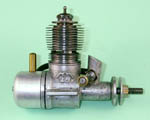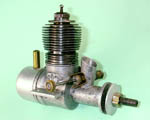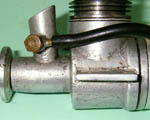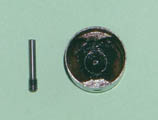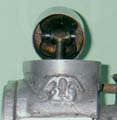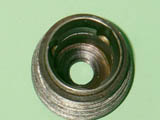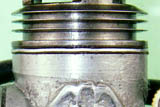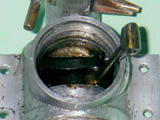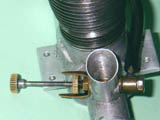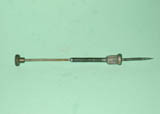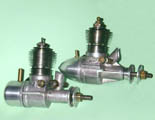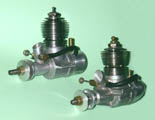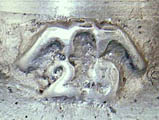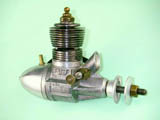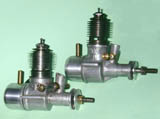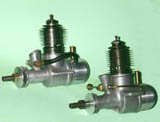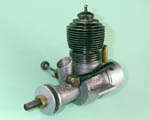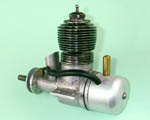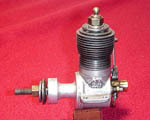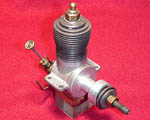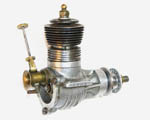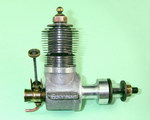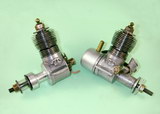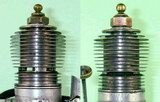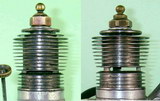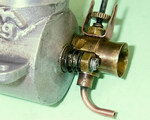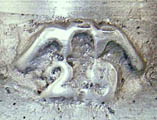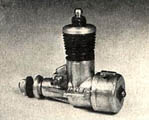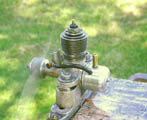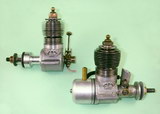Early Fuji 29, or ROC 29, or What!
by Adrian Duncan
Here we tackle something completely different—we take a close look at an interesting engine for which we have at best only a tentative identification! We don't even have confirmation of the engine's nationality, although a number of architectural and engineering design features strongly suggest a Japanese origin. Accordingly, please feel free to view this article as an in-depth whatizit!
The reason for our interest in this perhaps seemingly-inconsequential issue is that the engine in question appears to represent something of a "missing link" in the chain of Japanese model engine development in the early post-WW2 period. This very dynamic era of Japanese model engine development is unfortunately very sparsely documented in the English language. I say unfortunately because there's every indication that this was just as interesting and dynamic a chapter in model engine history as the parallel periods in America and Europe. It thus becomes important to record any and all evidence which may shed more light upon this fascinating period. Our hope is that the sharing of such information may challenge others who know more to produce additional evidence which may clarify some of the unresolved points.
In the present instance, the fact that my valued colleague Mel Reid and I have prepared a separate chapter on the Fuji 29 and 35 models in our series of articles dealing with the Fuji marque requires that we address the existence of this particular engine very directly, since it has been claimed by others to be a very early variant of the Fuji 29. We ourselves remain unconvinced of this identification, for reasons which we hope to make clear in the present article. Consequently, we have chosen to deal with it apart from the main Fuji series.
What follows is actually pretty much a detective story in which we take such clues as are on offer and try to form some plausible theories regarding the engine's identity and origin as we go. This being the case, we must stress at the outset that our conclusions cannot be taken as established fact but merely as working hypotheses. Our chief motivation for publishing this article is the earnest hope that someone who knows more than we do may read it and be prompted into presenting persuasive new evidence which clarifies matters for us. As always, any such contributions will be openly and gratefully acknowledged!
In such cases, it's always wise to start with what we know for certain. Here the one piece of hard evidence that we have is the engine itself. So it seems best to begin with a description of the engine as it unquestionably exists, setting aside the issues of identity and origin for later.
Description
The engine which forms the subject of this article is a very simple and lightweight 4.96 cc (.303 cu. in.) crankshaft front rotary valve (FRV) radially-ported glow-plug motor having a number of distinctive features. For one thing, it has a steel cylinder having a blind bore allied to thin integrally-machined cooling fins. For another, it sports a 3/8-24 glow-plug, a fitting which was abandoned fairly early on in the glow-plug era in favour of the familiar 1/4-32 item.
The engine is based upon a very plain brush-finished sand-cast crankcase with a screw-in backplate which is itself machined from a sand-casting. The castings are a little on the crude side and have a markedly porous character. In addition, there is a notable absence of any reinforcing webbing on the crankcase—indeed, a certain minimalist design philosophy is evident throughout the design. The absence of any stiffening web to reinforce the seemingly-vulnerable upright induction venturi tube is particularly noteworthy. The axially-located beam mounting lugs are rather on the thin side in addition to being completely unbraced. In all honesty, I wouldn't give much for this engine's chances of surviving a hard crash!
Despite the porous castings and the seemingly fragile nature of the design, it must be said that the quality of workmanship displayed in the engine's mechanical construction leaves little to be desired. All fits are of the highest order throughout, resulting in a unit which seems well able to give long and faithful service provided it isn't over-stressed and is kept out of hard impacts with the big green thing.
Measured bore and stroke of our subject are 19.0 mm and 17.5 mm respectively for a displacement of 4.96 cc (.303 cuin). These figures are significant, since they put the engine just above the 0.299 cuin maximum displacement for the American Class B rules, although taking full advantage of the 5 cc (0.305 cuin) displacement limit allowed under Japanese and European class rules. We shall refer to this fact again later in this article. The engine weighs a quite reasonable 186 gm (6.56 ounces) all complete as illustrated.
Removal of the screw-in cylinder gives us a look at the engine's interior, where we find some more interesting features. The rod is of hardened steel and is unusually skinny for an engine of this displacement—another minimalist design feature. The cast-iron piston is extremely lightweight and is machined away internally to logical limits, leaving only a pair of narrow gudgeon pin bosses to relieve the very thin walls.
However, the piece de resistance in minimalist terms is the gudgeon pin! The working diameter of this component where it passes through the con-rod small end is only 2.5 mm—a new record for a 5 cc engine in my personal experience! Even more individual is the method of installation of the pin. One end is externally threaded 3 mm and has a slot for a screwdriver. The other end is left plain at the 2.5 mm working diameter. The pin is inserted plain end first through a threaded hole in one of the piston bosses, from which it passes through the con-rod small end bearing and then engages with a blind unthreaded 2.5 mm hole in the opposite piston boss. The external 3 mm thread at the other end of the pin then engages with a matching thread in the other boss, allowing the pin to be screwed home tightly using a screwdriver in the outer (slotted) end.
The reason for such a set-up is made plain when one looks at the transfer porting. This consists of three fairly deep internal flute bypass passages which extend up the cylinder wall into the three columns which separate the three sawn exhaust ports. This arrangement allows the transfer ports to overlap the exhaust ports, with a small degree of overlap in fact being provided.
Since the cylinder is of the screw-in variety, there's no way in which its annular position can be guaranteed upon assembly. Hence some form of fixing for the gudgeon pin is necessary to prevent possible fouling of the transfer passages. The screw-in design described above is clearly the designer's response to this issue.
The arrangements for sealing the cylinder to the crankcase are interesting. There is a soft aluminium spacer sandwiched between two thin gaskets made of fibrous material. The intent of this arrangement must surely be to allow easy adjustment the compression ratio and port timing by using metal spacers of differing thicknesses. The presence of this feature raises the possibility that this may have been an experimental prototype which was specifically arranged to allow convenient alteration of these factors for comparative testing purposes. As currently set up, the engine has a checked compression ratio of 7:1 - a fairly typical figure for a sport glow-plug motor of the era.
There's no question that the spacer is an original feature—in its absence, the transfer ports on this example don't even open! Moreover, the compression ratio would become unacceptably high for an engine of this type. A somewhat parallel arrangement was used by Hope for the head seal featured in their very rare Super 60 model, of which more elsewhere. We shall recall this fact later.
When the engine was received following its acquisition through eBay, I naturally wanted to tear it down all the way to allow for full documentation. However, the backplate proved to be effectively "glued" in place courtesy of some well-hardened castor oil residue—even using heat, I was unable to shift it by "fair" means. In view of the engine's seeming rarity and fragility, I wasn't prepared to risk damage, so the backplate stayed in place.
Nonetheless, removal of the cylinder revealed the details already described and also allowed an inspection of the crankweb. This proved to be counterbalanced both by crescent-shaped cutaways on either side of the crankpin and by a hefty counterweight on the opposite side from the crankpin.�Given the relatively lightweight reciprocating components, one would expect vibration along the bore axis to be relatively minimal at the expense of some lateral vibration.
It was possible to determine that the internal gas passage in the crankshaft has a diameter of 7 mm in conjunction with a main journal diameter of 10 mm. A look down the intake venturi tube reveals that the induction port in the crankshaft is of the rectangular variety, which tends to promote more rapid opening and closing of the induction system. The throat diameter of the venturi tube is 6.5 mm.
The spraybar (which appears to be original) is a relatively substantial item having an external diameter of 3.5 mm which is externally threaded at both ends as well as being internally threaded for the needle. At the fuel delivery end, a banjo union is secured by a nut to provide a right-angle connection for the fuel line. At the needle end, a two-leaf bronze spring clip for needle tension is secured by a nut. The needle itself is externally threaded M2x0.4. It has both a serrated disc which engages with the spring clip for tension and a control knob at the outer end.
As received, the engine had a long flexible extension on the needle. This appeared to me to be an owner modification since the serrated brass disc which engages with the spring clip had a separate thimble of steel soldered onto its outer face to make the connection with what appeared to be a standard universal flexible extension. It seemed unlikely that any manufacturer would adopt such unnecessarily complex construction for a simple component like a needle, particularly a Japanese manufacturer at a time when minimalism was the guiding principle in engineering design. It appeared far more likely to me that someone had grafted a standard universal needle extension onto the original needle, a view which has been confirmed by later evidence (see below). The rigid needle in the illustrations is of my own manufacture, although I have naturally retained the previous fitting just in case it does turn out to be original.
The engine had no tank as received, although the presence of both a machined tank mounting lip and a tapped central boss on the backplate showed clearly that one had originally been fitted. Again, the tank in these images is of my own making.
Seem Familiar?
Well, it should! Anyone who is at all familiar with the original 1949 sand-cast model of the Fuji 29 glow-plug engine is probably already asking themselves why it's taken me so long to make the connection! The fact is that I made it immediately—one might well be forgiven for taking our subject to be a Fuji product or at least a Fuji clone. Indeed, when I first encountered the engine in the course of the previous owner's inquiries as to its origin, I initially assumed that it must be a Fuji prototype or an undocumented Fuji model. Moreover, at least one source in Japan has identified a related model as an early Fuji product (see below).
My subsequent inquiries have revealed that to date the only independent supporting evidence for this identification has been the general similarity of the two engines in terms of styling. In my personal view, it would be a great mistake to read too much into this. My valued friend and colleague Alan Strutt has pointed out that with the sole exception of Enya, all known Japanese manufacturers of the period with which we seem to be dealing made engines using radially ported cylinders with integral cooling fins. With the sole exception of OS (who used a separate alloy cylinder head), all of these manufacturers also used an integral cylinder head with a blind bore. In fact, this very minimalist design approach seems to have been very much de rigueur among Japanese model engine designers of the period. Accordingly, general similarities in terms of styling cannot be considered as persuasive evidence of a common origin.
Moreover, the quality of the castings used in the unknown engine seems very rustic, suggesting very much a start-up effort at a cottage-industry level. By contrast, the earliest confirmed Fuji models are relatively sophisticated in terms of the quality of their castings. Such considerations appear to me to argue quite strongly against a common origin, an argument which is supported by a number of other factors.
For starters, the very clear markings cast onto the right-hand side of the crankcase (facing in the direction of flight) do not conform to any previously-encountered Fuji identification. The engine bears the figure "29" cast in relief beneath a distinctive emblem reminiscent of a large bird stretching its wings. Fuji certainly never employed such an emblem on any of their previously-recognized models—in fact, all of their offerings from the very beginning in 1949 through to the end were clearly identified as Fuji products.
It's undeniably true that the emblem in question bears a superficial resemblance to the "Mount Fuji" symbol which appeared in some of the early Fuji company literature. However, this symbol did not appear on any known Fuji model which was contemporary with that literature. In addition, a search of Japanese trade-marks which was kindly undertaken by Mel Reid revealed that "Mount Fuji" emblems of this kind were quite commonly used by Japanese firms, both at the time in question and later. Consequently this emblem cannot be taken as firm evidence of a Fuji origin for this engine—we need far more than this.
A further issue is the fact that this engine bears no serial number. Without exception, every known Fuji model from the "classic" era bears a serial number. It seems highly unlikely that Fuji would have departed from this practise with their introductory models.
Even so, if the marking issue was the sole objection we might suspect an early Fuji identification which was quickly superseded. However, that issue is perhaps the least of the objections to a Fuji origin for this engine. Far more persuasive evidence contradicting such an origin is to be found in the engine's technical specification.
Firstly, although the unknown engine and the Fuji 29 share a common 19 mm bore, the stroke of our subject is longer at 17.5 mm as opposed to the Fuji's 17.0 mm. Secondly, the cylinder transfer porting set-up is completely different. In place of the three relatively deep internal transfer flutes in our subject engine, the earliest definitely-attributed Fuji 29 uses six shallow internal bypass flutes machined into the cylinder wall and terminating just below the exhaust port belt. In the case of the Fuji, the tops of these six internal flutes are circumferentially connected by a narrow annular channel which is machined for the full inside circumference of the cylinder wall, giving a true 360 degree transfer port. The same system had been used in the 1948 K engines in Britain.
It is not possible to provide any overlap between the transfer and exhaust porting using the Fuji arrangement. By contrast, the configuration used in our subject engine provides considerable flexibility in this regard—indeed, we have already noted that a small degree of overlap is in fact incorporated. Hence in some ways the mystery engine has a more sophisticated and certainly more flexible transfer system than the Fuji. The two arrangements are quite distinct.
There are many other differences as well. The illustrated Fuji 29 (serial number 2958) is one of the last ones made with the 3/8" plug (they switched to the 1/4" plug at around serial number 3000). It shows a number of improvements over the rather skimpy design of our subject. It has thicker beam mounting lugs set above the thrust line rather than along the axis, together with extensive bracing on the crankcase and a far more steeply-angled and well-braced induction tube. It uses a slightly thicker 3 mm gudgeon pin which is pressed in rather than screwed in and connects to the crankpin through a somewhat more substantial steel con-rod. It has fewer cooling fins on the cast-iron cylinder as well. It features a reduced stroke of only 17.0 mm, which brings it within the displacement limit for the American Class B rules. Finally, it uses a conventional needle valve having an externally-threaded spraybar which accommodates an internally-threaded thimble on the unthreaded rigid needle and is set at right angles to the engine's major axis rather than being angled back on the right as in our subject model. It also lacks the right-angled fuel connection of our subject model. Fuji were to employ this arrangement throughout the entire production life of the range.
Put simply, the Fuji is a significantly more substantially-engineered design than our unknown subject. Not surprisingly in view of this, it also weighs more at 205 gm (7.23 ounces) all inclusive. But it is undoubtedly the more sophisticated production of the two. It also complies with the American Class B rules.
Taking all of the above facts into account, the "early Fuji" claim for our subject engine's origin begins to wear a little thin! That said, the unknown engine undeniably has a superficial look about it of bearing some kind of relationship to the Fuji 29 model (or vice versa), despite the substantial differences in terms of design details and cast-on identification. The question naturally arises regarding the relative priority of the two designs. We know from Fuji's own statements that their earliest engines (including the sand-cast 29) dated from 1949. Where might we place our unknown subject in terms of dating?
Well, the fact that this engine is designed for a 3/8" glow plug strongly suggests an early date, certainly not later than 1949. Plugs of that size (or their 10 mm metric equivalent) had been used quite extensively during the spark-ignition era, and the availability of 3/8" glow plugs from early 1948 onwards was largely driven by the demand from modellers wishing to operate their old sparkers on glow-plug ignition. However, by 1949 the majority of new glow-plug designs were using the 1/4" plugs which were fast becoming the standard. By the end of that year, no-one was introducing new designs based on 3/8" plugs—indeed, established designs (such as the Fuji) were being switched over to the 1/4" plug, as noted earlier.
The subject engine has no provision for a timer. Hence it was unquestionably constructed from the outset as a glow-plug model. There may have been an earlier spark ignition version—we don't know. But we do know that the glow-plug era arrived a little later in Japan than it did in the USA, mainly due to a shortage of supply of the necessary plugs and the platinum-iridium wire needed to make them. It was not until the latter part of 1948 that Japanese manufacturers began to produce purpose-built glow-plug models.
We have also commented on the very minimalist nature of the engineering design of our unknown friend. In this context, it's worth reminding ourselves of the well-documented tendency among pre-war and early post-war Japanese designers to adopt a minimalist approach. Their engines were designed to do their job and nothing more, with a striking absence of features that did not contribute to that goal. This naturally resulted in minimal emphasis being placed upon styling along with a general avoidance of over-engineering. It also tended to result in lightweight engines which performed very well but were somewhat more fragile and utilitarian than their counterparts from elsewhere. It was only in the last year or so of the 1940's, as the marketing ambitions of Japanese manufacturers expanded in scope, that styling began to draw more attention from Japanese designers, together with greater concern for adequate structural integrity.
Our unknown subject fits right in with the Japanese early post-war minimalist philosophy, in contrast to the Fuji which demonstrates the beginnings of a move away from pure function towards a more stylish appearance coupled with enhanced structural integrity. Like the plug, this observation strongly implies a date for our subject somewhere near the beginning of the glow-plug era in Japan—late 1948 or perhaps early 1949.
Another factor indicative of an early date is the bore and stroke—we noted previously that our subject measures up at 19.0 mm and 17.5 mm respectively for a displacement of 4.96 cc or 0.303 cuin—just over the US Class B limit but taking full advantage of the 5 cc class limit allowed under Japanese and European competition rules. By 1949, when Fuji produced their original sandcast 29, adherence to the US rules was seen as commercially important, leading Fuji to adopt bore and stroke dimensions of 19.0 mm x 17.0 mm for a displacement of� 4.82 cc (.294 cuin) when launching their own new 29 model.
So we have a tentative date of late 1948 or perhaps early 1949 for the introduction of our subject, based on the evidence summarized above. This implies that its introduction likely preceded that of the more sophisticated Fuji, an observation to which we will have further occasion to refer. We've also seen that although there are superficial architectural similarities, the design fundamentals of the unknown model and the Fuji are in fact completely different. Is there any other early post-war Japanese design (always assuming our subject to be Japanese!) which might offer a possible connection at the time in question? As it happens, there is! Let's look at that next...
A Possible Hope Connection
Regular readers of these pages will recall our earlier article in which we discussed the original Hope .29 cuin design, the Hope B. As soon as we think of that model, a number of obvious design similarities between it and our subject come immediately to mind.
Firstly, the crankcase design (minimal bracing, near-upright induction venturi, screw-in cylinder and backplate, etc) and the style of casting (a bit porous, with a brushed finish) seen in our unknown subject are very similar indeed to the parallel features of the Hope B, although the Hope does have a single bracing web beneath the main bearing. Other features such as the square-on-shaft prop driver mounting, the needle valve style, the crankweb design, the very skimpy con-rod and the screw-in method of securing the gudgeon are common both to the unknown engine and the Hope B.
Moreover, the cylinder porting with its three internal bypass flutes is a direct reflection of the Hope B, as is the blind bore with integral fins. In fact, the cylinder design is essentially identical to that of the Hope B apart from the bore. Finally, the major crankshaft design features and dimensions (apart from the stroke) appear to be common to both designs.
As soon as we make the above connection, it becomes far more logical to see our unknown engine as a development of the Hope B rather than a predecessor of the Fuji 29. Although there are obvious departures in terms of external appearance, the design fundamentals of the unknown motor and the Hope B are strikingly similar. In technical terms, there's far more to connect the unknown engine to the Hope B than there is to the Fuji 29—in fact, when you get right down to it the only connection with the latter is the general external styling of the cylinder unit! It would be highly unusual to see so many fundamental design changes between an original model and its successor design from the same maker.
A further indication of a possible Hope connection is to be found in the previously-described composite cylinder base sealing system. It will be recalled that this seal was created using two thin fibre gaskets with an aluminium spacer sandwiched between them. The apparent intent was to allow for adjustments to the compression ratio and port timing. This precisely mirrored the approach taken by Hope in their limited-edition Super 60 racing model which we have described elsewhere.
Based on the above working hypothesis, I modeled both the tank and needle seen in the attached images of our unknown engine on the equivalent components used with the Hope B. Since an original Hope B tank fits the unknown engine's backplate perfectly, the use of a replica seemed completely appropriate. Moreover, an original Hope B needle was a perfect match for the unknown engine's spraybar. I have no authoritative basis for claiming the accuracy of the replica components, but the engine looks right and works well with these items fitted. I can always make more accurate parts if additional information becomes available.
As ever, one insight leads to another—if we accept that the unknown engine may be a late 1948 development of the Hope B design by another maker, then it could have owed nothing to the Fuji 29 in design terms. The Hope B was introduced in glow-plug form in 1948, using many of the design features seen in our unknown subject. So its design was there to be drawn upon, but the Fuji's wasn't—it didn't appear until some point in 1949.
Looking at this situation, it suddenly becomes very easy to see the unknown engine as a development of the Hope B by a different maker. It's equally easy to see the resulting design having some influence over the general styling of the later Fuji 29 model. However, it bears repeating that the Fuji reflected very few of the unknown model's engineering design features. The greater sophistication of the Fuji design is entirely consistent with a later date together with the idea that Fuji may have seen merit in the architecture of the unknown engine and set out to develop their own similarly-styled design.
We must now repeat our original cautionary note and remind our readers that the above analysis represents nothing more than a working hypothesis which seems to us to make the greatest possible sense out of what we observe. Any discussion of an unknown engine's origins must at least do that! There are doubtless other possibilities, and we strongly caution readers against accepting the above remarks as established fact pending the uncovering of more evidence. What can be stated directly is that the strength of the above line of reasoning is such that the presently-unsubstantiated claim of an early Fuji identification would require a significant body of irrefutable independent supporting evidence before we could accept it.
So What Happened?
With the caveat that none of this can be proved at the present time, here's my working hypothesis. My present suspicion is that the unknown engine was the product of someone—perhaps a former associate of the Hope manufacturers—who looked at the Hope B and thought that he could do better. The main changes that he clearly saw as being desirable were the adoption of short-stroke internal geometry to facilitate the attainment of higher speeds along with some improvements in the general styling of the engine. But he saw no need to beef up the engineering design, remaining in the minimalist design camp. He also retained the 3/8" plug which was used in the earlier Hope B glow-plug models.
By late 1948 or early 1949 our unknown maker had come up with the subject engine as we now see it and had begun to make it in small quantities, perhaps working more or less alone. Meanwhile, the founder(s) of the Fuji range (which we have covered in a separate series of articles) were getting set to enter the field themselves in early 1949.�They took a look at the subject engine and liked its general style. They either persuaded the designer to come on board and help them produce an improved version under the Fuji banner with revised transfer porting and such, or they simply copied certain elements of the overall architecture while adding their own engineering modifications. Certainly, the Fuji is a more sophisticated production than the unknown model, so this fits ...
In my view, the idea of our unknown designer joining forces with Fuji is perhaps more plausible based upon circumstantial considerations, because otherwise he'd surely have carried on manufacturing and developing his design and we'd see more examples of his work than we actually do—this is the sole example of this engine that I've ever seen, so it's pretty rare. We might also expect to see other models from the same stable.
Of course, it's equally possible that our unknown maker was simply driven from the marketplace by the advent of the more sophisticated Fuji model. We simply don't know at this point ... we need help!
An RRV Version of the Unknown Engine�
After I began work on this article, I received word from an eBay contact with whom I have had many satisfactory dealings that he had a "racing" rear rotary disc valve (RRV) twin ball-race version of the same engine. He was convinced that it was an early Fuji product, but it turned out upon closer inquiry that this opinion was based entirely on the unsupported statement of a single contact in Japan. He was unable to produce any documentary or other evidence to support the identification.
Regardless, this is clearly an RRV "racing" version of the FRV model in my possession. The identification cast onto the crankcase is identical, as is the cylinder design to all appearances. However, the cast-on identification is located on the opposite side of the engine, an apparent anomaly which is easily explained. The RRV version was clearly based upon the same crankcase casting. However, the integral backplate of the RRV version was produced by the simple expedient of machining off the entire plain bearing section forward of the crankcase (without of course drilling and reaming the main bearing!) and drilling and tapping the resulting backplate surface for the venturi and disc valve spindle. The twin ball-race main bearing housing of the RRV version simply screws into the same location thread that was used for the backplate in the FRV model. A very economical conversion, it must be said.
It seems logical to assume that this variant used the same bore and stroke as its FRV companion, allied presumably with identical internal components. However, confirmation of this must await an opportunity to examine an actual example. The one point of interest is that the needle on this example is virtually identical to the Hope B-based component which I made for my own FRV model prior to becoming aware of the existence of this second example. In fact, the needle valve assembly as a whole appears identical to that of the Hope B. This seems to represent a pretty solid independent vindication of my earlier deductions regarding the form and possible source of the original needle.
In defense of his views regarding the engine's Fuji origins, my contact pointed out quite correctly that Fuji produced limited numbers of a twin ball-race RRV version of their previously-illustrated 1949 FRV model. The mystery engines certainly fit into the same pattern. However, so did the products of a number of other makers. This logic would argue that McCoy and Dooling engines were from the same maker despite their quite distinct design features and cast-on identification, since both appeared in 5 cc and 10cc RRV versions!
Quite apart from this, the divergences in terms of engineering design between these and the Fuji models are far more significant than we would generally expect to see in a normal development progression carried through in a very short space of time by the same manufacturer. In particular, the construction features of the RRV versions of the Fuji 29 and the unknown model are even more divergent than those of the FRV versions. The Fuji 29 RRV uses a main casting which incorporates the main bearing housing in unit, in contrast to the unknown engine�s separate screw-in main bearing housing. In addition, the Fuji uses a separate backplate which is attached with three screws which engage with tapped holes in "mouse-ear" lugs formed integrally with the main crankcase casting. Overall, the design features of the RRV models are even more divergent than those of the FRV versions.
Hence, until compelling independent evidence of a Fuji origin for these engines is presented, I am personally unable to recognize this identification as established, although I freely acknowledge that it is among the possibilities. In making the above statement, I fully realize that there will be those who do not agree with me. As always, I'm quite prepared to accept that my conclusions may be in error. However, I have formed those conclusions based upon what I consider to be objective consideration of the balance of the presently-available evidence. If anyone out there has persuasive evidence which demonstrates that I'm wrong, MEN will gladly publish it with full acknowledgement in an addendum to this article.
The RRV Version Under Examination
More or less coincidentally with the initial submission of this article for publication, I was privileged to acquire the RRV engine discussed in the previous section. As it turned out, it was fortunate indeed that I did so, since a direct examination of the engine answered a number of questions which, while not providing a definitive resolution of our quest for enlightenment, did nonetheless reinforce some of the tentative conclusions presented earlier.
For the most part, the engine proved to be just as described in the previous section of this article. There�s no doubt at all that it�s based upon the same crankcase casting as the FRV version. I was able to confirm that the bore and stroke were unchanged at 19.0 mm and 17.5 mm respectively for an unaltered displacement of 4.96 cc (0.303 cuin.), still over the American Class B rules. Weight proved to be almost exactly 7 ounces (198 gm), fractionally greater than that of the FRV version. No doubt the twin ball races account for most of the difference.
My attempts to dismantle the engine for internal examination proved as fruitless as they had been for the FRV model—both the cylinder and main bearing housing resisted any attempt to remove them by "fair" means. One actually wonders if some form of thread-locker was used ......Given the engine�s seeming rarity and fragility, I elected to leave well alone.
Nonetheless, it was possible to confirm that the RRV model evidently uses the same con-rod and gudgeon pin setup as the FRV variant. The slotted end of the ultra-skinny screw-in gudgeon pin is clearly visible through one of the exhaust ports.
The biggest surprise came when I turned my attention to the cylinder. I immediately noticed something that I should have seen before in the images—the cylinder of the RRV model is actually quite different from that of the FRV version! The initial giveaway is the fact that the RRV cylinder has four cooling fins below the exhaust ports, while the FRV model has only three. The two cylinders are seemingly identical above the exhaust ports.
Looking closely at the exhaust ports themselves, it became immediately apparent that they are shallower on the RRV model than they are on the FRV version. The depth of the RRV exhaust ports is only 1.5 mm as compared to the 2.0 mm depth of the FRV ports. Moreover, the pillars of metal separating the three exhaust ports are notably narrower in the RRV cylinder. The difference in port area is thus not as great as it might otherwise have been.
This of course prompted me to look closely at what could be seen of the transfer porting. The 3/8 in. hole for the plug allows the cylinder interior to be both well illuminated and easily inspected, making it possible to confirm that the transfer porting is completely different from that used in the FRV model. There is a continuous channel running around the bore just below exhaust port level. This is supplied with mixture by six shallow bypass flutes formed in the lower cylinder wall. In fact, the porting in the RRV model is identical to that observed in the original Fuji FRV and RRV models!
This is the first hard evidence so far encountered of a possible design connection between these engines and the early models which are definitely attributable to Fuji. Now before we get too excited here and start shouting "Eureka!", it�s important to recognize that this feature does not constitute proof of a Fuji manufacturing origin for the RRV engine—merely that its cylinder porting design may well have directly influenced that of the Fuji offerings. With the exception of this one feature, the rest of the RRV model bears almost no resemblance to its Fuji equivalent. In particular, apart from the common porting arrangement the cylinder of the Fuji is quite different from that of our RRV subject, being both shorter and having fewer fins along with taller exhaust ports. Accordingly, we still require independent evidence of a Fuji manufacturing origin if we are to accept such an identification as established—evidence of design influence in a single feature is by no means enough on its own.
A number of other points arising from the direct examination of this engine seem worth mentioning. The use of a twin ball-race shaft makes it clear that the RRV model was intended to be a "high performance" alternative to the FRV variant. Although it retains a 3.5 mm diameter spraybar, the venturi throat diameter has been increased slightly from 6.5 mm to a full 7 mm. This should improve breathing a little while still retaining adequate suction. The shorter gas passage and quicker cut-off provided by the disc valve should also help. The compression ratio of the RRV version has been raised a little also—a volumetric check confirmed a figure of 9:1 as compared to the 7:1 figure measured for the FRV model. Incidentally, the checked compression ratio of the Fuji 29 FRV model is 8:1—another point of departure in design terms.
The disc valve mounting is of some interest. The disc itself appears to be made of aluminium alloy—not the best material for the job, but quite commonly used at the time regardless. The disc is mounted on a steel spindle which rotates with the disc and passes through a bearing drilled in the centre of the integral backplate. The assembly is lightly tensioned by a coil spring. This spring is retained by a nut which threads onto the outer end of the spindle, allowing the tension in the system to be easily adjusted. The spring rotates with the spindle and bears on a thin bronze washer which acts as a thrust plate between the spring and the rear face of the backplate.
Overall, I would expect this version of the engine to out-perform the FRV model, albeit probably not by as much as one might expect. In all honesty, I see this engine as more of a high-performance "sports" engine than as a true racing unit. Nonetheless, a comparative test of the two models side by side should prove interesting! I will get to that when time and opportunity permit, with a further addendum to this article reporting results.
It appears to be a not-unreasonable inference that the FRV model seemingly based on the Hope B came first, after which the designer decided to seek higher performance with a more sophisticated version of the engine. In pursuit of this goal, he changed the main bearing, the cylinder design and the means of induction while still using the same basic working components and main casting. The similarity of the redesigned cylinder porting to that of the Fuji 29 models undoubtedly implies a degree of design influence between the two models, although this implication falls well short of confirming a common manufacturing origin. That said, these observations do appear to reinforce the possibility that these engines were in effect prototypes made by an individual who later became involved with the commercial Fuji operation, as postulated earlier.
OK, So What is IT?
We hope that we have shown that whatever this engine is, its identification by some individuals as a Fuji product is presently unsupported by any irrefutable evidence. In fact, almost all of the technical evidence embodied in the engine itself directly contradicts that identification. But then, if it isn't a Fuji, what is it?!?
The short and simple answer is of course that we don�t know for sure! In considering this point, we are forced yet again into the realm of informed speculation—we reiterate that none of what follows may be regarded as established fact. We have noted that one possible origin for these engines would be their construction by someone who later became instrumental in getting the Fuji operation off the ground on a commercial basis. This would not make them Fuji products per se - rather, they could then be considered as in effect pre-production prototypes of what was to become the Fuji range.
Another possibility is that these engines were indeed commercial products, albeit by some firm or individual other than Fuji. In this regard, there is a candidate name for this engine which is consistent with all of the surrounding circumstances. Purely for discussion purposes, we submit that there is at least a possibility (and no more) that the engines described above are products of the ultra-rare ROC marque which is known to have traded in Japan up to the early 1950's.
The emblem cast onto the side of the engine is one piece of evidence for this proposition. As we saw earlier, this has the appearance of a large bird stretching its wings in preparation for flight.
The roc is just such a creature—a very large mythical bird traditionally noted for its awesome power.
 A very suitable name for a model aero engine, in fact, particularly in Asia where the legend of the roc was well established and where names drawn from the metaphysical were very common! The attached artistic impressions of the roc certainly bear direct comparison with the emblem on the engine under discussion. So we have an emblem and a name that is logically and culturally consistent with that emblem and is moreover attested in the literature of Japanese model engine production.
A very suitable name for a model aero engine, in fact, particularly in Asia where the legend of the roc was well established and where names drawn from the metaphysical were very common! The attached artistic impressions of the roc certainly bear direct comparison with the emblem on the engine under discussion. So we have an emblem and a name that is logically and culturally consistent with that emblem and is moreover attested in the literature of Japanese model engine production.
Now we must admit right here that we have been unable to find any mention of a ROC 29 in the available literature. However, it must be recalled that the mystery engine appears to date from a period in Japanese model engine history which is almost completely undocumented, at least in the English language. The absence of any such reference is therefore hardly surprising, nor does it by any means preclude the possible existence of a ROC 29.
However, the existence of the ROC model engine marque is most definitely attested! There are several authoritative references to a very different model—the ROC .049. This engine was featured in articles by Peter Chinn which appeared in the September 1955 issue of Model Aircraft and the November 1956 issue of Model Airplane News. The one available image shows that its design was closely based upon that of the OK Cub .049 which had first appeared in 1949. Although it was clearly out of production as of 1955 (it was not included in Chinn's listing of glow engines for 1954/55 which appeared in the May 1955 issue of Model Aircraft), Chinn retrospectively recorded it as having been the first Japanese .049 model to appear in the marketplace. Since the sandcast Fuji .049 was released in late 1950, the ROC .049 must have made its debut prior to that date. This puts it at just the right time to be a successor to the earlier ROC 29, if indeed that is what we are dealing with here.
Continuing our working hypothesis, we saw that the designer of the ROC 29 (which we will call it for now on the clear understanding that this identification is by no means secure) may possibly have joined Fuji for a while to assist them in the development of their own .29 cuin model based very loosely on the earlier ROC. If so, this arrangement didn't last—it would seem that our unknown designer may have broken away from Fuji again to go on his own (as he might have done earlier with Hope), resuming the use of his former brand name and producing his own .049 model, once again anticipating the release of Fuji's own .049 offering.
Anyway, for now we'll refer to this unknown engine rightly or wrongly as a ROC 29, purely for convenience. As stated earlier, we'd be more than happy to be proved wrong, but only through the submission of persuasive independent evidence. We will gladly eat a healthy helping of crow pie in such an eventuality! Crow pie actually tastes remarkably good when served up with a healthy garnish of authoritative new facts!
How Does it Run?
Well, very nicely indeed, as it happens! I took it out to the local flying field and set it up in the test stand on a warm summer's day. I had no intention of pushing it too hard—I just wanted to experience its qualities. A fuel containing 10% nitro and plenty of castor oil was used since it was all that I had available at the time.
The handling qualities of the engine may perhaps best be summarized by stating quite truthfully that I gave it 7 runs and only needed 7 flicks to do so! I guessed more or less correctly on the initial needle setting, and the engine literally started on a prime first flick EVERY time, with no tendency to backfire, no sagging and no trace of a misfire at any speed. What a sweetheart of an engine!� Not as powerful as an O.S. twin-stack 29 tested at the same time, but not bad! Response to the needle was outstanding, and it was very easy to establish an optimum setting at all speeds tested.
We previously noted the heavy counterbalancing of the crankweb coupled with the relatively lightweight reciprocating components. As one might expect, this had the effect of keeping vibration well under control, and the engine was unusually vibration-free in operation, at least in the test stand.
The replica Hope B back tank was used for all tests, giving a leaned-out running time of 2 minutes 20 seconds on a 10x4 prop—a bit long for free flight but certainly appropriate for such use if allowed to run down to a pre-determined extent before launching or filled initially with a pre-determined volume of fuel. Prop-rpm test results were as follows, with implied approximate power outputs shown in brackets:
| Prop | Speed | Output |
|---|---|---|
| APC 10x6 GF | 9,000 rpm | 0.270 BHP |
| Taipan 10x4 GF | 10,300 rpm | 0.280 BHP |
| Taipan 9x4 GF | 11,600 rpm | 0.306 BHP |
| APC 9x4 GF | 11,900 rpm | 0.313 BHP |
These figures are of course insufficient to allow the development of a meaningful power curve. They do however suggest a peak output of somewhere around 0.32 BHP at 12,000 rpm together with a very flat peak—an extremely useful performance if this engine is indeed a late 1948 or early 1949 predecessor of the original Fuji 29, as hypothesised above. A Hope B tested some time ago on 10% nitro fuel and the same Taipan 10x4 prop from my test set only managed 8,500 rpm on that prop, so the ROC exhibits a marked improvement in performance over the Hope B, at least on that load.
In Summary
So there we have it! We appear to be dealing with a directly-related pair of engines of probable (but not confirmed) Japanese origin which may perhaps represent a design link between the Hope B of 1947/48 and the Fuji 29 of 1949. The construction of the engines constitutes a highly instructive illustration of the minimalist design philosophy which prevailed among Japanese model engine designers during the early post-WW2 period.
Although there is currently no authoritative supporting evidence, we submit that there is at least a possibility that our subject engine is a ROC 29 dating from early 1949. Other possibilities undoubtedly exist, one of which is that these could be in effect experimental prototypes made by someone who later became involved with the Fuji company. However none of these possibilities are presently supported by any persuasive evidence either. Until more evidence comes to light, that's where we'll have to leave this discussion. If anyone out there can make a positive identification with supporting evidence, please put us out of our misery!
Regardless of what it actually is, this is a very nice engine indeed and a real pleasure to run. Although we might feel that it is a bit under-engineered in some respects, there's no doubt that it would give a careful owner many hours of good service.
We remain hopeful that further information may come to light at some point in the future. As always, we will of course share any such information freely, with full acknowledgement of its source. In the meantime, keep an eye open for more examples—they must surely be out there somewhere!
